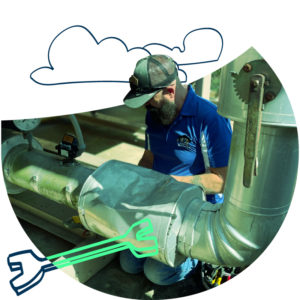For facilities managers, the new year is a time for reflection and planning. While 2024 marks a fresh start and new opportunities, facilities managers know that ongoing challenges lie ahead—a sentiment shared across the education sector. Facilities managers at public schools in particular are well aware of the condition of their assets and infrastructure; in a 2020 report, the U.S. Government Accountability Office found that 54% of public school districts needed to update or replace systems or assets in school buildings. But beyond the age and state of school facilities, the industry is facing additional obstacles like navigating the changing workforce and widening skills gap, conducting operations efficiently, and managing growing amounts of complex data. We believe that when facilities professionals focus on solving these challenges with data-powered, value-driven intelligence, they will realize increased efficiency, productivity, and a benefit to their bottom line.
Challenge: Navigating the changing workforce
Although it may seem that the workforce is always in a state of flux, the current transformation is profound, driven by technological advancements, demographic shifts, and changing expectations. One of the largest technological shifts is the development and adoption of artificial intelligence (AI), which touts the ability to eliminate repetitive, mundane work tasks, among other advantages. As AI’s presence continues to grow—40% of respondents in a recent survey currently use AI in their organizations and plan to increase their overall AI investment—employees will need to reskill to manage AI and automation in facilities management.
 Beyond upskilling, another workforce challenge is navigating shifting demographics. As Generation X and Millennial employees enter leadership positions, Generation Z (as of 2023, those between the ages of 11 and 26) is entering the workforce and Baby Boomers are retiring. When employees leave the facilities industry, they take valuable skills and knowledge with them. Some skills and knowledge transfer can be done, but it is nearly impossible to transfer all of an employee’s knowledge, and new employees may need many years to gain the same insights and skills.
Beyond upskilling, another workforce challenge is navigating shifting demographics. As Generation X and Millennial employees enter leadership positions, Generation Z (as of 2023, those between the ages of 11 and 26) is entering the workforce and Baby Boomers are retiring. When employees leave the facilities industry, they take valuable skills and knowledge with them. Some skills and knowledge transfer can be done, but it is nearly impossible to transfer all of an employee’s knowledge, and new employees may need many years to gain the same insights and skills.
Facilities managers are already seeing technological integrations revolutionize the way they work, from deploying smart sensors and automating processes to improving operations and asset maintenance and investment planning. This technology adoption has proven to help educational institutions secure funding by providing concrete proof through data collection and asset tracking. For instance, because the Waco Independent School District (Texas) knew the conditions of its facilities via tracking software, it strategically prioritized which ones to replace, allowing it to secure a $355 million bond to replace five school buildings. Without this insight, the district would not have obtained sufficient funds for its projects, highlighting the importance of asset tracking to provide clear evidence of health and status. Tracking software also facilitates easy and efficient documentation, enabling all employees to input collected data into one place.
The changing workforce demographic also signifies a culture shift. Gen Z employees bring high expectations of technology use and remote or flexible work, requiring the industry to adapt to attract and retain employees. Many facilities have adopted mobile technology to receive work orders and maintenance requests in the field and have implemented asset management software to track the health and data of facility assets. As the workforce evolves, this kind of engagement with technology will become a necessity to continue attracting younger generations.
Challenge: Driving operational efficiency in space management
Operational efficiency remains a perennial concern for facilities managers, and the bar keeps rising in the face of technological advancement and the need for sustainable practices, especially in the education industry. There are many facets to operational efficiency, but by tackling inefficiency at its core, facilities managers can identify and implement solutions to address the root causes that may have kept them from keeping educational institutions assets and infrastructure up to date.
The Verona Area School District (Wisconsin) realized its system for renting out facilities space beyond school hours was inefficient. The district holds many events at its facilities throughout the year, but the time it took to schedule, set up, tear down, and clean after each event resulted in wasted money, time, and resources. To manage facilities-related tasks more efficiently, including event scheduling, custodial staff scheduling, client billing, and client information reporting, the district implemented a dedicated software solution. The technology enabled greater visibility into which facilities were available when and which custodial tasks needed to be completed, resulting in time savings and revenue increases. This enhanced visibility also meant the school district could expand facilities rentals beyond school-related functions, allowing local communities and citizens to rent, maximizing facilities use and revenue.

Verona Area School District (Wisconsin) implemented a dedicated software solution to manage facilities tasks related to renting out facilities space (such as this auditorium) beyond school hours.
Facilities managers are often challenged with finding ways to make their operations more efficient, but they can tackle these tasks with the right mix of processes, technologies, and people and can reap benefits including increased revenue and funding potential, improved learning environments for students, escalated teacher satisfaction, and less wasted time and resources. By adopting software solutions to keep track of all maintenance, updates, and repairs, facilities professionals maintain access to this crucial data in one centralized location, allowing them to easily manage the data and harness it for strategic decision-making.
Challenge: Utilizing strategic data management
Data is the new currency—it powers everything. But it can be challenging to collect and harness facilities data to make strategic, informed decisions. One example of a school district using data strategically is Baltimore City Public Schools (Maryland). With 150 different school buildings spanning a 19-mile radius, the district leveraged software to track, manage, and report on its facilities maintenance data. When it needed to justify capital project requests to state government and local stakeholders, the district was able to provide detailed information on line items such as spending on preventive maintenance and reactive maintenance. Utilizing data in these ways enabled facilities staff to demonstrate concrete proof of asset health and status to show how state funding could help avoid asset failure. This is a prime example of the power data management can yield to support decision making, especially when critical funding is at stake.
By deciphering their facility data, managers can forecast the impact of their spending decisions and deferred maintenance, improve funding requests, support smarter budgeting and planning, and identify and streamline utility waste.
As pressure to adopt sustainable practices and reduce carbon emissions increases, data can also unlock powerful insights that help managers inform leadership of the decisions to make and when to make them. By deciphering their facility data, managers can forecast the impact of their spending decisions and deferred maintenance, improve funding requests, support smarter budgeting and planning, and identify and streamline utility waste.
Wake Forest University (North Carolina) improved operations and drove clear return on investment by tracking and managing its data more efficiently in ways that became invaluable during the COVID-19 pandemic. The university’s growing campus—approximately 9,000 students with more than 80 buildings across 340 acres—meant facilities leaders needed a better way to track and report on the health and status of assets and work orders. A new software tracking solution helped the facilities team track costs and usage, improving efficiency and data accessibility pre-COVID 19. This increased accessibility proved to be a game-changer for the university throughout the pandemic when the facilities division received an influx of questions about the campus’s air quality and flow. To answer these inquiries—and to address the health and safety concerns of students and faculty—the facilities team used the software to swiftly gather essential information about assets, quickly identify the types and health of air filters used across campus buildings, and upgrade filters in high-traffic areas.

Wake Forest University has approximately 9,000 students with more than 80 buildings across 340 acres.
Data can also be harnessed specifically to understand energy savings and support overarching sustainability efforts. With a software solution that tracks energy usage, Wake Forest was able to better understand the environmental impact of its assets and facilities by monitoring energy consumption and providing a clear picture into energy use. This real-time visibility into energy spent also enabled facilities managers to quickly implement waste-reduction procedures.
Additionally, the digital system’s mobile app allowed employees to access work orders and information more easily to complete jobs. Not only do mobile apps save time and increase operational efficiency, but they also help organizations adjust to changing workforce demographics.
The year ahead
While facilities managers will likely continue to face these challenges in 2024 and beyond, the new year marks a fresh start to tackle a changing workforce, create more efficient operations, and manage growing data sets. When facilities professionals, especially those working in education, focus on value-driven intelligence, they can solve pressing challenges while realizing increased efficiency and productivity.
Dan Arant, CEM, PEM, is North America sales manager of energy and ESG at Brightly Software, a Siemens company. Read case studies at https://www.brightlysoftware.com/success-stories.



